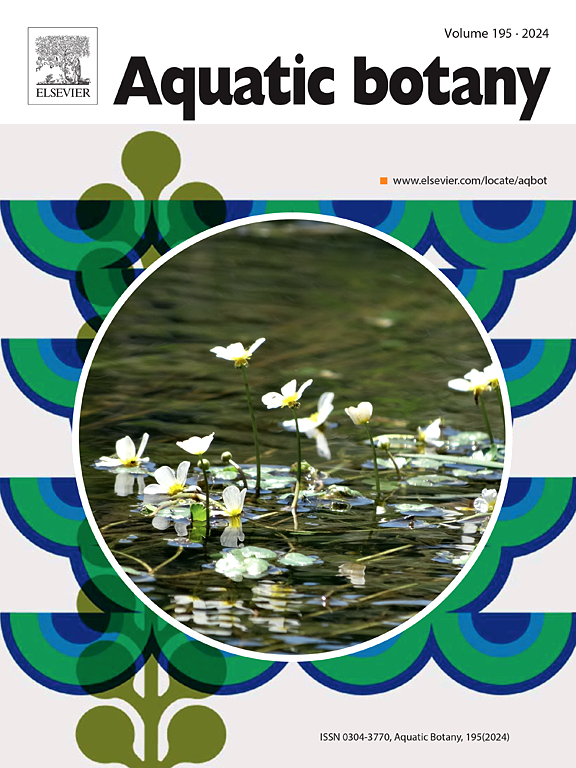A Pleistocene legacy of gene pools, ecodemes and admixtures of Stuckenia pectinata (L.) Börner as evidenced from microsatellites, complete chloroplast genomes and ribosomal RNA cistron (Europe, Africa)
IF 2.6
4区 生物学
Q2 MARINE & FRESHWATER BIOLOGY
引用次数: 0
Abstract
Stuckenia pectinata (L.) Börner is a widely distributed submerged plant well-studied for its ecology, distribution, and molecular diversity. Globally, various genotypic lineages and hybrids of Stuckenia species have been identified using nuclear rRNA (ITS) and chloroplast sequences (notably rpl20–5’rps12 and trnT-trnL). These studies have shown intraspecific variability in S. pectinata, with two gene pools ('genotype 1a' and '1b') reported for Europe and Africa. Moreover, former isozyme research suggested distinct freshwater and brackish water gene pools. Therefore, our primary objective was to determine whether these ecodemes correspond to either 'genotype 1a' or '1b'. Using fifteen nuclear microsatellite loci, complete chloroplast genome sequences (156,677 bp), and the rRNA cistron (7178 bp), we analyzed the genetic identity of 313 S. pectinata samples (representing 124 unique clones) from 12 populations in Europe and Africa. Chloroplast genomes of three African Rift lake populations corresponded to ‘genotype 1b’, while those of nine European populations to ‘genotype 1a’. Microsatellites also clearly distinguished ‘genotype 1a’ from ‘1b’ in an individual PCoA and STRUCTURE analysis, whereas incomplete homogenization of 5S-rRNA sequences suggested either ongoing differentiation or intraspecific hybridization between ‘genotype 1a’ and ‘1b’. Haplotype lineages, rRNA cistron mutations, and microsatellites revealed an additional subdivision within ‘genotype 1a’, potentially distinguishing a freshwater gene pool from a brackish water one. Approximate Bayesian computation analyses using nuclear microsatellites supported a demographic expansion model and a time of divergence, for the African Rift lake populations as well as for the European freshwater and brackish water populations, dating back to the Late Pleistocene. Divergent chloroplast lineages appeared to be already present during the Last Glacial Maximum. Stuckenia pectinata from Lake Hora (Ethiopia), Lake Balaton (Hungary) and the Camargue (France) each harbored two distinct maternal haplotypes, from Selinunte (Italy) indicated F1 hybrids whereas from Lake Peipsi (Estonia), amongst others, showed incomplete rRNA homogenization. It is hypothesized that contemporary S. pectinata populations, especially in Europe, retained a legacy of ancient gene pool differentiation despite a history of hybridization, admixture, and chloroplast capture. It is recommended that studies on the ecology and reproductive strategies of this seemingly common and widespread species should take into account its genetic identity.
从微卫星、完整叶绿体基因组和核糖体 RNA cistron(欧洲、非洲)证明的 Stuckenia pectinata (L.) Börner 的更新世基因库、生态模式和混合物遗产
Stuckenia pectinata (L.) Börner 是一种广泛分布的沉水植物,其生态学、分布和分子多样性均得到了深入研究。在全球范围内,利用核 rRNA(ITS)和叶绿体序列(特别是 rpl20-5'rps12 和 trnT-trnL)已确定了 Stuckenia 物种的各种基因型系和杂交种。这些研究显示了 S. pectinata 的种内变异性,欧洲和非洲有两个基因库("基因型 1a" 和 "1b")。此外,以前的同工酶研究表明,淡水和咸水基因库各不相同。因此,我们的主要目标是确定这些生态模式是否对应于 "基因型 1a "或 "1b"。我们利用 15 个核微卫星位点、完整的叶绿体基因组序列(156677 bp)和 rRNA 单体(7178 bp),分析了来自欧洲和非洲 12 个种群的 313 个 S. pectinata 样本(代表 124 个独特克隆)的遗传特征。三个非洲裂谷湖种群的叶绿体基因组对应 "基因型 1b",而九个欧洲种群的叶绿体基因组对应 "基因型 1a"。在个体 PCoA 和 STRUCTURE 分析中,微卫星也明确区分了 "基因型 1a "和 "基因型 1b",而 5S-rRNA 序列的不完全同质化表明,"基因型 1a "和 "基因型 1b" 之间存在持续分化或种内杂交。单倍型系谱、rRNA 单体突变和微卫星揭示了 "基因型 1a "内部的另一个分支,可能区分淡水基因库和咸水基因库。利用核微卫星进行的近似贝叶斯计算分析支持非洲裂谷湖种群以及欧洲淡水和咸水种群的人口扩张模型和分化时间,可追溯到晚更新世。不同的叶绿体系似乎在末次冰川极盛时期就已出现。来自霍拉湖(埃塞俄比亚)、巴拉顿湖(匈牙利)和卡马格湖(法国)的 Stuckenia pectinata 都带有两种不同的母系单倍型,来自塞利农特(意大利)的 Stuckenia pectinata 则显示出 F1 杂交,而来自佩皮西湖(爱沙尼亚)等地的 Stuckenia pectinata 则显示出不完全的 rRNA 同源化。据此推测,尽管经历了杂交、混合和叶绿体捕获,但当代 S. pectinata 种群(尤其是欧洲种群)仍保留了古老基因库分化的遗产。建议对这一看似常见且分布广泛的物种的生态学和繁殖策略进行研究时,应考虑到其遗传特性。
本文章由计算机程序翻译,如有差异,请以英文原文为准。
求助全文
约1分钟内获得全文
求助全文
来源期刊

Aquatic Botany
生物-海洋与淡水生物学
CiteScore
3.80
自引率
5.60%
发文量
70
审稿时长
6 months
期刊介绍:
Aquatic Botany offers a platform for papers relevant to a broad international readership on fundamental and applied aspects of marine and freshwater macroscopic plants in a context of ecology or environmental biology. This includes molecular, biochemical and physiological aspects of macroscopic aquatic plants as well as the classification, structure, function, dynamics and ecological interactions in plant-dominated aquatic communities and ecosystems. It is an outlet for papers dealing with research on the consequences of disturbance and stressors (e.g. environmental fluctuations and climate change, pollution, grazing and pathogens), use and management of aquatic plants (plant production and decomposition, commercial harvest, plant control) and the conservation of aquatic plant communities (breeding, transplantation and restoration). Specialized publications on certain rare taxa or papers on aquatic macroscopic plants from under-represented regions in the world can also find their place, subject to editor evaluation. Studies on fungi or microalgae will remain outside the scope of Aquatic Botany.
 求助内容:
求助内容: 应助结果提醒方式:
应助结果提醒方式:


